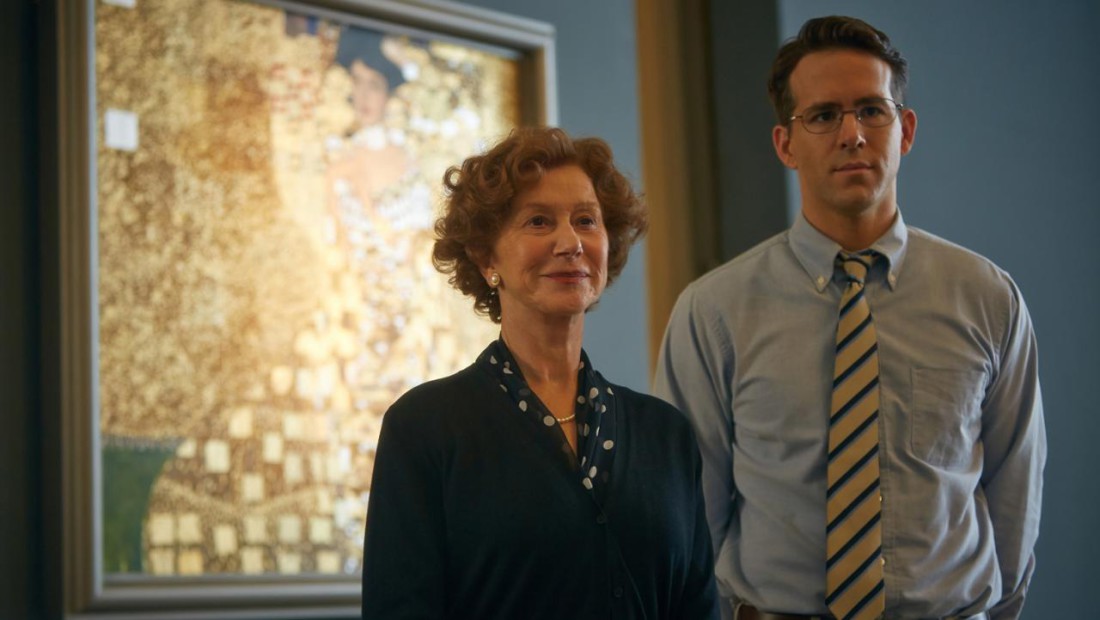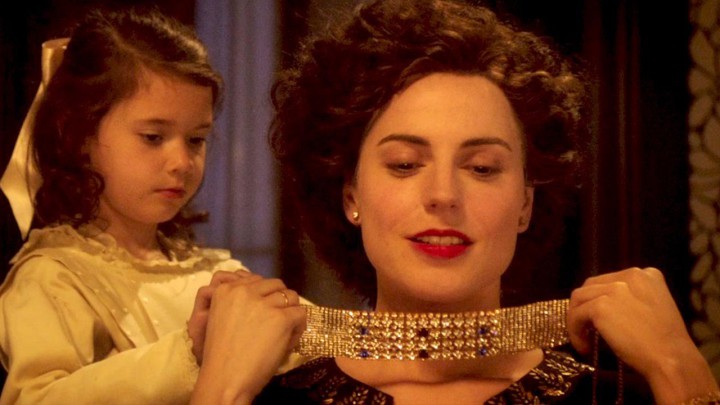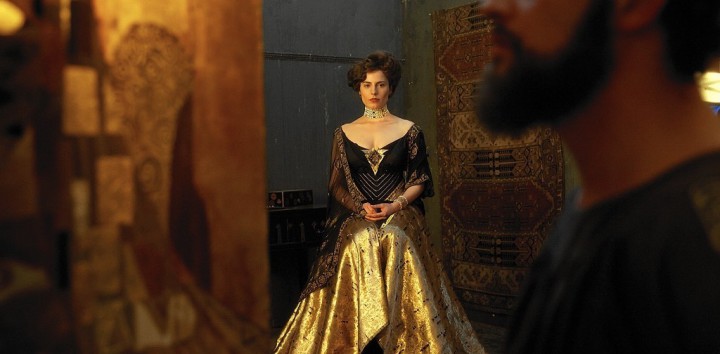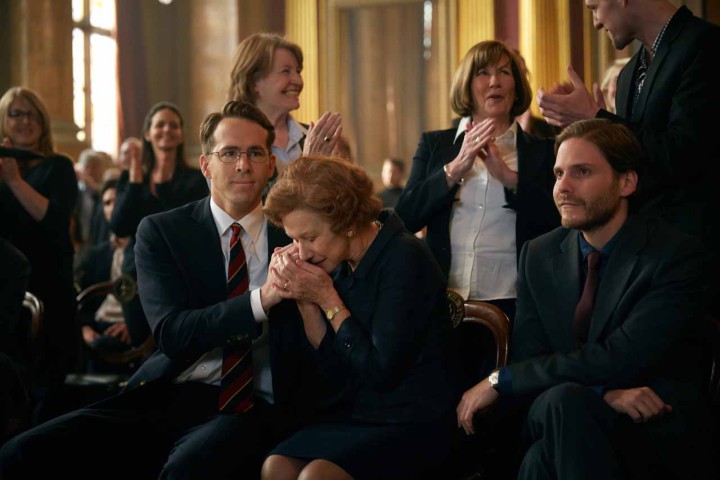Yes, Simon Curtis’ Woman in Gold is on the middlebrow side. At any other time of the year, we’d call it Oscar-bait. And, yes, there’s a certain by-the-numbers quality to it. Plus, first-time screenwriter Alexi Kaye Campbell has turned the story — perhaps inescapably — into something like Stephen Frears’ Philomena (2013), with Nazis and a stolen painting replacing nuns and a lost child. (This is especially true in the relationship between Helen Mirren and Ryan Reynolds.) But the truth is Curtis has so carefully crafted the film, and Mirren and Reynolds have such terrific chemistry, that it mostly works — and it works pretty well at that. Viewers who go to see the film because it stars Helen Mirren will not be disappointed, and they may be startled by how very good Ryan Reynolds is.
The film — told in a surprisingly well-judged mosaic of different eras — relates the history of the Gustav Klimt painting of the title from its creation to its “confiscation” by the Nazis to its post-war reappearance in a Viennese museum to the legal battle for it launched against the Austrian government by Maria Altmann (Mirren), now a widow running a dress shop in Los Angeles. The painting — actually titled Portrait of Adele Block-Bauer until its identity was taken away from it — was commissioned by Maria’s uncle as a portrait of his wife (Antje Traue). In her view, it’s less a great work of art valued at over $100 million than it’s a picture of her aunt — but more, it’s something that connects to her family, most of whom died under the Nazis. With the death of her sister, Maria is the only family member left standing. This — and the news that Austria is making efforts to return stolen works of art to their rightful owners — prompts her to take a stab at reclaiming the painting.
Enter lawyer Randol Schoenberg (Reynolds) — courtesy of his mother. He’s the grandson of composer Arnold Shoenberg, whom he never knew, but Maria did (Klimt was not the only luminary to spend time at her family’s home). At the beginning of the film, Randol is down on his luck, following a disastrous attempt at opening his own practice. Not only does he know nothing about this area of law, he’s just landed a position with a high-powered law firm that promises him security and solvency. But Maria Altmann is not so easily put off — and when Randol learns the value of the painting, he tries to sell his firm on the case. His boss (Charles Dance) is unimpressed, noting that the Austrians are not likely to give up something so famous, but he allows Randol one week to go to Vienna and put in the claim. This one week will cost Randol his job and several years of his life.
Much of what makes all this work is the rapport between the two stars and the way that their characters drive each other to pursue the case. The process turns out to be frustrating at every turn, since, as Austrian journalist Hubertus Czernin (Daniel Brühl) points out to them, the whole restitution business is little more than empty PR for the government. The attempt is to look good, not to actually return Nazi loot to its rightful owners. But there are other fine points to the movie, especially the way the past is worked into the story, filling in gaps in Maria’s story and the history of her family and the painting. This is cannily handled, especially in the way — late in the film — that past and present bleed into each other. Some of it is overstated and geared toward clichés of WWII melodrama. A great deal of it, however, plays with forceful emotion. It’s the sense of true emotions that keeps it all afloat.
A great many critics (roughly half on Rotten Tomatoes) seem to have it in for Woman in Gold — and not just on the basis of how it dramatizes the facts in the case (pretty much a given when dealing with this kind of material), but that’s the crux of it. I’m not sure why. I don’t find the film any more specious than, say, The Imitation Game (2014). They’re cut from the same tasteful BBCish cloth. If anything — clichés to one side — Woman in Gold is more cinematically adventurous than many of its critically acclaimed brethren. Is it a great movie? No. Few films of this sort are. They’re the modern equivalent of those old Warner Bros. biopics like The Life of Emile Zola (1937) — factual up to a point, but simplified for purposes of dramatic entertainment. And that’s what this is — dramatic entertainment. On that basis, it succeeds admirably. Rated PG-13 for some thematic elements and brief strong language.









Having just watched Reynolds in THE VOICES I am no longer one of those who will be surprised to find how good his acting is in this film. Judging from the previews of THE CAPTIVE he’s equally impressive there.
Not sure The Voices got much of a release. Ditto The Captive. These may be contributing factors in my being surprised by him here.
I think I saw earlier this week or last that The Voices was already out on DVD.
I think both of those Harry mentioned are.
I am not as smitten by this movie as most of my friends. Though you put this in the same “specious” realm of the IMITATION GAME in terms of taking liberties with the facts, I found this much less compelling. For one, the writing of the modern scenes was so predictable and flat. . The segments that take us back into her past are more artfully done and thus, to me, much more engaging. It could have been my mood, but Helen Mirren ( who I usually admire) seemed a bit too casual most of the time. I am aware that the similarities to PHILOMENA might have gotten in the way. I was hopelessly in love with all aspects of that movie and the comparisons just kept wandering into my mind as I watched this just a few hours ago. The fact that I haven’t much tossed any parts of the movie around in my feeble brain until now also tells me that it had very little impact on me. But again, comparisons are toxic and can inhibit enjoying a thing on its own merit.
Comparisons may be odious, but they’re kind of inevitable if you have the frame of reference. The problem to me is when it goes to extent of disliking a thing for what it isn’t rather than for what it is.
I hope that isn’t the case for me. But it might be.
I wasn’t accusing you. It’s just something I’ve noticed over the years, starting about 30 years ago when I realized that people were disliking Tod Browning’s Dracula for not being as good as James Whale’s Frankenstein — and that that seemed to be the only reason.
I wish I could find this little volume of Leigh Hunt essays I picked up nigh on to 40 years ago in a used book. But I can neither find it, nor the quote it contained, which is something like “Let us continue to like that which is likable in anything, and to render it unlikable because of its inferiority to something else.” I think I have the actual quote in an article I wrote for Films in Review when Rouben Mamoulian died and was discussing the fact that Mamoulian divided people into two camps of the Mamoulian vs. Lubitsch type, much like the Chaplin vs. Keaton and Lugosi vs. Karloff ones.
After reading a bit about Mamoulian, I sense the camps ( Mamoulian vs. Lubtitsch) had to with his directing style which was more about creating a poetic, non realistic look in his films. Of course I am just guessing. If we choose one style over another, I understand that. I think I prefer Woody Allen to most other director’s of comic films. But I don’t consciously compare others while I watch him. I am not ‘in his camp”. In terms of experiencing a film, I was just not as drawn to the story in Woman in Gold. The stakes may not be high enough. And when Maria gives up hope, I found myself dropping out of the game as well. Oh well. It is nice to have a place to write about an experience with a film. Though I am clearly the most pedestrian voice on your comment thread, it is nice to have a conversation about this.
I’d be surprised if you did compare other comedies to Allen’s, because so few are anything like his. The Mamoulian/Lubitsch thing is grounded in the fact that Mamoulian made a musical with Maurice Chevalier and Jeanette MacDonald, stars associated with Lubitsch. Lubitsch had first co-starred them in 1929 in The Love Parade, used MacDonald in Monte Carlo (1931) and Chevalier in The Smiling Lieutenant (1931). Then re-teamed them for One Hour with You (1932) and used them once more in The Merry Widow (1934). So when Paramount head Adolph Zukor asked Mamoulian to make a film with them — 1932’s Love Me Tonight (one of my top three movies) — comparisons were inevitable. Then, too, both were stylists. The primary difference is that Mamoulian was a little flashier in his effects (that happened a lot with people who came from the theater and found a freedom in film they’d never known, esp, back then) and was more inclined to mix stylization with naturalism. Lubitsch shot on soundstages most of the time. Mamoulian liked to take his cast and camera outdoors.
While I prefer Love Me Tonight to the Lubitsch musicals, I love all these films. Now, in the case of Chaplin and Keaton, I’m a firm Chaplinist. And with Lugosi and Karloff, I am a Lugosiphile to my very core.
well..here’s a question. If you are in the camps of Chaplin and Lugosi, does that mean that you don’t find something to appreciate in the work of Keaton and Karloff? Do you spend time consciously comparing them when you are watching the work of one or the other?
I guess I am in the Shakespeare camp, when compared to Christopher Marlowe? Yes. I could say that.
But for the most part, I am not a camper.
No, it’s not a matter of actively comparing them. It’s simply the realization — over a period of time — of whose work I prefer. In these cases where I’ve seen nearly everything that there is to see, I think that’s hardly unreasonable. It may mean that I don’t really like Keaton, though, because I pretty much don’t — and that has nothing to do with how popular it became in the 1970s to lionize Keaton at Chaplin’s expense.
That makes sense. You have seen everything and your life’s work is formulating and articulating your opinions. It would follow that you have developed a predilection for one artist over another. I guess if I look at my preferences in the theater, I would choose playwrights that would put me squarely in their camp. Of course I worship at the altar of Tennessee Williams, Eugene O’Neill, Arthur Miller, George Bernard Shaw, and of course Will Shagspur ( as he was sometimes called)